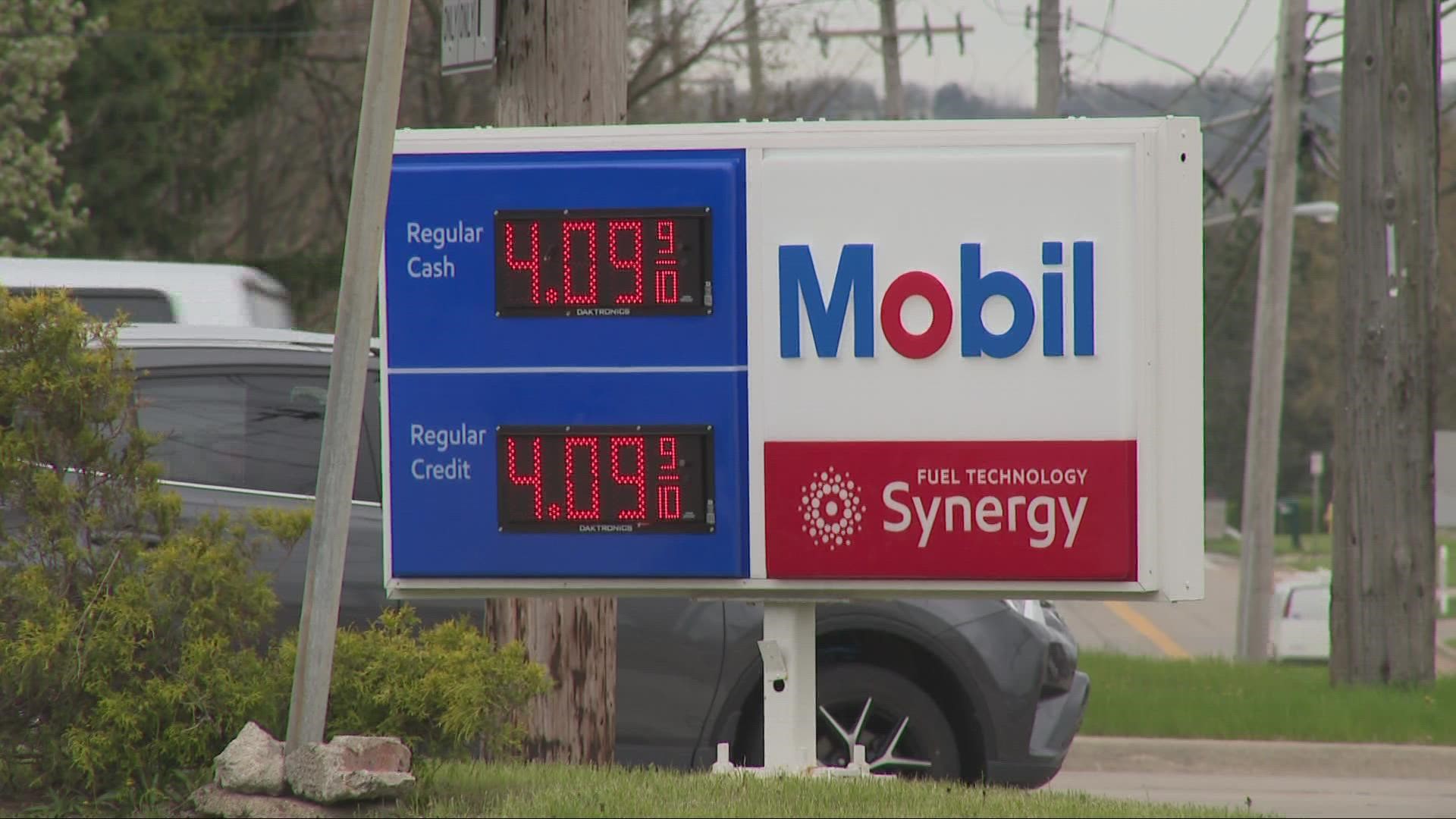CLEVELAND — Gas prices are on the rise once again throughout Northeast Ohio with drivers experiencing yet another spike at the pump.
GasBuddy announced early Monday that prices in Akron have risen 44.9 cents per gallon within the last week. That puts the average price in Akron at $4.11 per gallon.
Cleveland, meanwhile is also up by 26.1 cents per gallon. The new average price per gallon now stands at $4.08. That puts Cleveland’s gas prices $1.28 higher than a year ago.
LIST & MAP: Find the cheapest gas prices near you
The national average has also experienced an increase of 6.9 cents per gallon in the last week, according to GasBuddy, with the average cost now $4.17.
According to Michael Goldberg, associate professor in the department of design and innovation at the Weatherhead School of Management and executive director of the Veale Institute for Entrepreneurship at Case Western Reserve University, there are a number of factors that contribute to this spike in prices.
"When you look at the supply shortage, there's a number of factors that are going into this," Goldberg said. "One is the continued conflict in the Ukraine, and while the U.S. is not heavily reliant on Russian oil, other parts of the world are, and that's causing a shortage in overall supply."
"Secondly, certain countries, particularly in the OPEC cartel, they're not necessarily incentivized to increase the supply," he said. "The U.S. has been working with allies to try to pressure some of the oil producers to sort of open up the spigots a bit, but higher prices and short supply can actually be quite good for suppliers of oil, so that is another challenge."
Goldberg also mentioned factors like increased demand now that people are driving more than earlier on in the pandemic, when people may have been working from home or holding off on traveling.
Goldberg pointed out that increased prices for gasoline may also impact costs for transporting products and bringing goods and services to shops and homes, ultimately lending to increased prices passed on to consumers.
"The gas prices are not just felt by those that want to fill up our tanks and drive for our vacations," he said. "It’s bringing our goods and services to our homes."
All of this is occurring as the unofficial start of the summer travel season, Memorial Day, quickly approaches.
"Summer blend gasoline has been hitting the markets across the country which is more expensive to produce, so that elevates the cost of gasoline," said Jim Garrity, spokesperson for AAA East Central. "And we’re getting into the time of the year when more and more people drive to begin with because it’s the summer driving months coming up."
Garrity warned that people should be prepared and ready to budget for possible price increases, and said that it may be a busy travel season as people finally go on those vacations they've previously canceled or pushed back due to COVID.
Patrick De Haan, head of petroleum analysis at GasBuddy, said he hopes that prices will begin to slow or at least plateau. However, he emphasized how global events will impact prices.
According to De Haan, as long as Russia's war on Ukraine continues, he anticipates prices of gasoline and oil "will remain elevated," but also said that continued COVID lockdowns in China could drive prices down. Ultimately, he said people are in for what could be a volatile summer when it comes to prices at the pump.
“Gasoline prices have continued their rally in the last week with oil prices sustaining higher levels, but the real story has been diesel fuel, which has skyrocketed to its highest level ever seen. Diesel is now $1 per gallon or more in many areas compared to gasoline," said De Haan. "The meteoric rise in diesel prices is likely to continue for the first half of the week at least, while gasoline prices could continue to see a slow but steady rise. For now, the rising cost of diesel will surely be felt in the grocery store, hardware store or on your next flight as jet fuel prices accelerate, leading to a continued rise in inflation likely to ripple across the economy.”
Here are historical gasoline prices in Cleveland and the national average going back 10 years:
- May 2, 2021: $2.80/g (U.S. Average: $2.89/g)
- May 2, 2020: $1.57/g (U.S. Average: $1.76/g)
- May 2, 2019: $2.74/g (U.S. Average: $2.90/g)
- May 2, 2018: $2.68/g (U.S. Average: $2.82/g)
- May 2, 2017: $2.27/g (U.S. Average: $2.37/g)
- May 2, 2016: $2.27/g (U.S. Average: $2.22/g)
- May 2, 2015: $2.45/g (U.S. Average: $2.61/g)
- May 2, 2014: $3.69/g (U.S. Average: $3.68/g)
- May 2, 2013: $3.74/g (U.S. Average: $3.53/g)
- May 2, 2012: $3.71/g (U.S. Average: $3.80/g)
MORE HEADLINES:
Editor's note: Video in the player above was originally published in an unrelated article on April 29, 2022.

